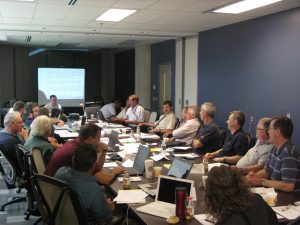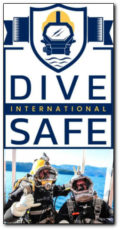CANADIAN DIVE STANDARDS – 50 YEARS OF ONGOING DEVELOPMENT
By CADC Admin ~ July 16th, 2020. Filed under: Safety, Standards and Regulations.
 This year, 2020 marks the 50th anniversary of national health and safety standards for occupational diving and hyperbaric facilities in Canada. Let’s dive into the story behind the six standards in place today.
This year, 2020 marks the 50th anniversary of national health and safety standards for occupational diving and hyperbaric facilities in Canada. Let’s dive into the story behind the six standards in place today.
Following inquiries into several fatalities and serious accidents in the late 1960s, a decision was made by the diving industry and federal / provincial regulatory authorities to develop the first nationwide safety standard for occupational divers. In parallel with this effort, a decision was made to begin work on a standard for hyperbaric facilities that supported occupational diving in many locations across the country. The federal government (Labour Canada) asked the Department of National Defence to lend its expertise to these projects. Together, the early supporters of this proposal approached the Canadian Standards Association to undertake these projects using its consensus process for gaining agreement among all stakeholders. The CSA readily agreed to these laudable projects and quickly formed two committees—one to develop a standard for hyperbaric facilities, and the other to develop a safety code for diving operations. These became CSA Z275.1 and Z275.2, respectively.
In those early years, gaining consensus of diverse stakeholders across the country wasn’t easy. And not everyone was enamoured with the idea of creating national standards. Some were quite suspicious that safety standards would be used as a club to force changes to the industry, while others saw it as a potential threat to their professional livelihood. Organizing meetings and corresponding by mail also posed challenges to the progress of work by those pioneers.
In fact, the time required to convince most diving professionals that standards were needed, plus the time it took to obtain agreement on the contents of those first editions, resulted in the standards taking four years to complete and publish. But once they were released in 1974, they became the backbone to professional underwater work in Canada. (ED NOTE: Several CADC members were on those original committees. Doug Elsey / Bob Landry / Phil Nuytten. CADC has had active involvement in the development of dive standards in Canada)
As these two initial standards came into greater use in various types of underwater work, others took notice of their success. In 1973, work began on a safety standard for caisson work and for work in pressurized tunnels. This new standard’s work took advantage of the decompression tables that had been developed by the Defence and Civil Institute of Environmental Medicine (DCIEM, now the DRDC) by adapting them for terrestrial work in pressurized-air environments. That standard became the Safety Code for Construction Work in Compressed Air (CSA Z275.3).
Later editions of the Safety Code for Diving Operations (CSA Z275.2) identified the need for ways to assess the competencies of divers and dive support personnel. The need was especially great among the offshore petroleum sector, but it was also felt among divers in the construction sector and those performing infrastructure maintenance.
In the mid-1990s, this need spurred the development of the Competency Standard for Diving Operations (CSA Z275.4). Initially, this standard was used by the National Energy Board for certifying divers for the offshore sector and by diving contractors for assessment of new candidates seeking work as divers, tenders, or supervisors. Soon after the turn of the century, the CSA Diving Competency Standard received a large boost, when it became the basis for the newly-formed Canadian diver certification system (administered by the Diver Certification Board of Canada (DCBC)). In 2002, and then again in 2012, the scope of CSA Z275.4 was expanded. In its present form, the Competency Standard covers 32 categories of professionals associated with the diving sector, including divers, diving support personnel, hyperbaric chamber staff, and ROV operators.
But the CSA Technical Committee didn’t stop there. It went on to establish a national standard on occupational diving training in 2005 (CSA Z275.5) and a diving standard specifically designed for work with unexploded ordinance and munitions (CSA Z275.6) in 2011. The training standard is now used for the evaluation of training programs offered by colleges and training institutions throughout North America. The UXO, Munitions & Police Explosive Diving Standard is used by the Department of National Defence, police services, and other security services for assessing risk and underwater work in the vicinity of potential explosive threats.
We tip our hats in remembrance of those who bravely stepped forward 50 years ago to fight for safety throughout the occupational diving sector. Because of their conviction, and because they believed the common good of professional diving across Canada would overcome the finger-pointing of political inquiries, they were able to establish a lasting safety legacy. We should be proud of these Canadian standards and hold them high for the world to see and emulate.
Because of the experts and passionate safety advocates who serve on the CSA Z275 Technical Committees today, we can be confident in both the acceptance and the quality of these standards that are referenced in all Canadian jurisdictions.
Thank you to the members of the Canadian Association of Diving Contractors for 50 years of diving safety standards.
By Dave Shanahan was WPS Standards project manager at CSA Group. He worked at CSA Group for over 20 year before he retired in June 2020.






